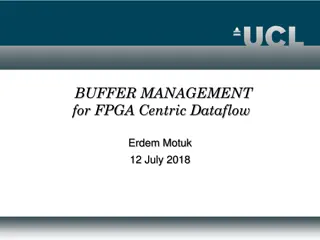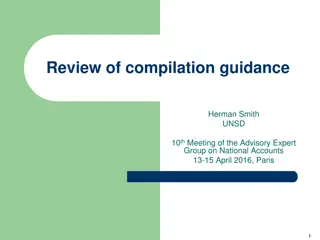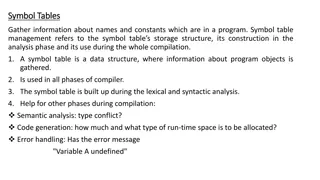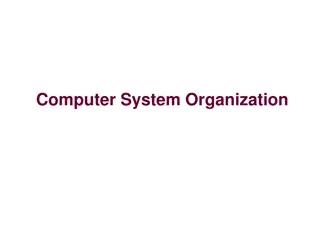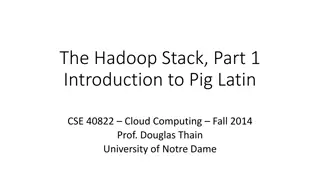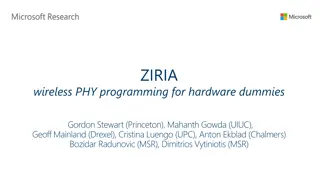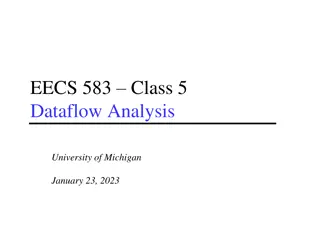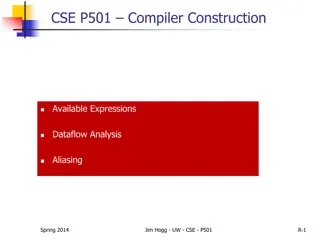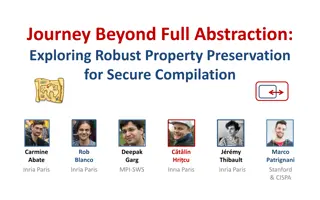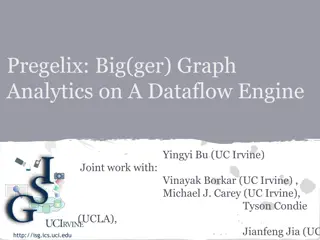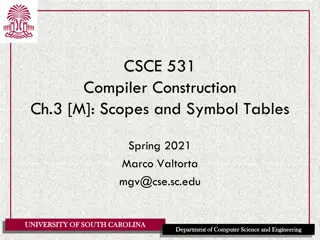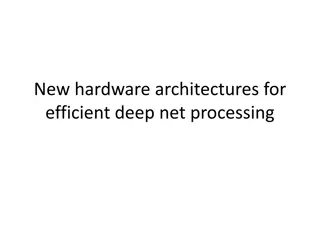Understanding Dataflow Analysis Frameworks in Compilation
Dataflow analysis plays a crucial role in compilation by computing dataflow facts within basic blocks, using transfer functions and merge operators for inter-block analysis. This process helps in achieving convergence iteratively to a fixpoint, ensuring soundness, precision, and efficiency in runtime scenarios. Frameworks provide a mathematical structure to unify different analyses, aiding in understanding commonalities and facilitating the development of new analyses.
Download Presentation

Please find below an Image/Link to download the presentation.
The content on the website is provided AS IS for your information and personal use only. It may not be sold, licensed, or shared on other websites without obtaining consent from the author. Download presentation by click this link. If you encounter any issues during the download, it is possible that the publisher has removed the file from their server.
E N D
Presentation Transcript
CSc 553 Principles of Compilation 10. Dataflow Analysis Frameworks Saumya Debray The University of Arizona Tucson, AZ 85721
Dataflow analysis: commonalities dataflow equations merge operator forward reaching defns. available exprs. out[B] = fB (in[B]) backward liveness ? in[B] = fB(out[B]) boundary value all 2
Dataflow analysis: commonalities The analyses compute sets of "dataflow facts" for each basic block B: in[B], out[B] computed iteratively to convergence ("fixpoint") intra-block analysis: uses a "transfer function" fB that captures the effects of B forward analyses: out[B] = fB(in[B]) backward analyses: in[B] = fB(out[B]) inter-block analysis: uses a "merge operator" "for some path" ( ) analyses: "for all paths" ( ) analyses: 3
Dataflow analysis: questions Given some dataflow analysis A: Is it sound? do the results account for all possible runtime scenarios? under what assumptions? Is it precise? how good are the results? Is it efficient? how fast does it run? 4
Dataflow analysis frameworks Provides a unifying mathematical structure underlying these analyses helps explain why the analyses are the way they are helps us understand commonalities between different analyses Makes it easier to figure out the details of new analyses Helps answer questions about soundness, precision, efficiency 5
Partial order Definition: A binary relation over a set S is a partial order if it satisfies: x S: x x (reflexive) x, y S : x y and y x implies x = y (anti-symmetric) x, y, z S : x y and y z implies x z (transitive) Notation: (S, ) denotes a set S with a relation if is a partial order on a set S, then (S, ) is called a partially ordered set (poset) 7
EXERCISE EXERCISE Which of these are partial orders? Why or why not? ( , ) where is the set of integers ( , <) (set of all finite ASCII strings; lexicographic ordering) (S, R) where: S = the set of all UA students, and x, y S : x R y iff x and y have the same last name (S, R) where: S = the set of all UA students, and x, y S : x R y iff x and y are friends 8
Monotonicity Given a poset (S, ), a function f: S S is said to be monotone iff x, y S: x y f(x) f(y) Intuition: If f is monotone, then a bigger input yields a bigger (or same) output 9
Meets and joins Given a poset (S, ) and a, b S: c S is a join of a and b (denoted a b) iff: a c and b c; and there is no x S : a x c and b x c c is also called the least upper bound (LUB) of a and b d S is a meet of a and b (denoted a b) iff: d a and d b; and there is no x S : d x a and d x b d is also called the greatest lower bound (GLB) of a and b 10
Lattices Definition [lattice]: A poset (S, ) is a lattice iff every pair of elements x, y S has a unique meet and a unique join Note: this implies that every non-empty finite subset of S has a unique meet and join Definition [complete lattice]: A complete lattice is a lattice (S, ) where every subset X S has a unique meet and join Fact: A complete lattice (S, ) has a least element ("bottom") and a greatest element ("top") 11
Example The set of all subsets of {a, b, c} ordered by : {a,b,c} lattice ordering: meet: join: {a,c} {a,b} {b,c} {b} {a} {c} 12
Example a poset that is not a lattice (why?) a poset that is a lattice 13
Semilattices Definition [semilattice]: A join-semilattice is a poset (S, ) where every pair of elements has a unique join A meet-semilattice is a poset (S, ) where every pair of elements has a unique meet Fact: If (S, ) is a lattice then (S, ) is a join- semilattice and a meet-semilattice 14
EXERCISE EXERCISE Consider (B3, ) where: B3 is the set of length-3 bit-vectors, i.e., B3 = {000, 001, 010, 011, 100, 101, 110, 111} x, y B3: x y iff #1s(x) #1s (y) Questions: is a partial order? is (B3, ) a lattice? what is the meet operation? what is the join operation? is it a complete lattice? #1s(u) = the number of 1s in u e.g., #1s(011) = 2 15
EXERCISE EXERCISE Consider (B*, ) where: B* is the set of all finite-length bit-vectors, i.e., B* = { , 0, 1, 00, 01, 10, 11, 000, 010, 011, 100, } x, y B*: x y iff #1s(x) #1s (y) Questions: is a partial order? is (B*, ) a lattice? #1s(u) = the number of 1s in u e.g., #1s(011) = 2 16
EXERCISE EXERCISE Consider (?( ), ): is this a poset? is it a join-semilattice? what is the join operation? is it a meet-semilattice? what is the meet operation? is it a lattice? is it a complete lattice? 17
Dataflow analysis frameworks 18
Transfer functions for basic blocks Dataflow equations: Reaching definitions: in[B] = {out[p] | p preds[B]} out[B] = gen[B] (in[B] kill[B]) transfer function for B captures how the code in B affects the relationship between in[B] and out[B] gen[B], kill[B] depend only on B can be considered to be fixed for any given B Available expressions: in[B] = {out[p] | p preds[B]} out[B] = gen[B] (in[B] kill[B]) 19
EXERCISE EXERCISE B0 Analysis: reaching definitions x = 1 y = 2 z = x + y What are the transfer functions for each of the blocks B0, B1, and B2? How are these transfer functions affected if we add an edge B0 B2 ? B1 y = 2 * z x = y z z = z 1 B2 x = y + x y = z y 20
EXERCISE EXERCISE B0 Analysis: variable liveness x = 1 y = 2 z = x + y What are the transfer functions for each of the blocks B0, B1, and B2? How are these transfer functions affected if x is also live at the end of B2? B1 y = 2 * z x = y z z = z 1 B2 x = y + x y = z y y is live 21
Transfer functions: properties f(x) = C1 (x C2) Monotone: x1 x2 f(x1) f(x2) Closed under composition: suppose f(x) = C1 (x C2), g(x) = D1 (x D2) (f g)(x) = f(g(x)) = (C1 D1) (x (C2 D2)) g f g f Can be identity: C1 = , C2 = f(x) = x 22
Axioms for transfer functions The set of transfer functions F satisfies the axioms: f F : f is monotone id F F is closed under composition 23
Dataflow analysis frameworks A dataflow analysis framework consists of: a control flow graph G = (V, E) a complete lattice L with meet operation the domain of dataflow facts a transfer function F that associates each node b V with a monotone function fb : L L an initial value vENTRY (or vEXIT) that gives the lattice value for the entry (or exit) blocks 24
EXERCISE EXERCISE Suppose that: L is a complete lattice with ordering and meet f : L L is monotone w.r.t x, y L What is the relationship (in terms of ) between: f(x y) and f(x) f(y) ? 25
Example 1: gen-kill analyses Available expressions Live variables Domain sets of expressions sets of variables forward: OUT[b] = fb(IN[b]) IN[b] = {OUT[x]|x pred(b)} backward: IN[b] = fb(OUT[b]) OUT[b] = {IN[x]|x succ(b)} Direction fb(x) = (x killb) genb fb(x) = (x defb) useb Transfer function Meet operation Boundary condition IN[entry] = IN[exit] = Initialization values (interior blocks b) IN[b] = IN[b] = set of all variables 26
Example 2: Constant propagation 1. Domain of analysis The analysis propagates sets of mappings from variables in the CFG to their values. E.g.: [ x 2, y undef, z NAC ] undef : we don t yet know anything about its value NAC : (maybe) not a constant 27
Example 2: Constant propagation 2. The lattice ordering We use a product lattice with one component for each variable in the program for a program with variables x1, x2, , xn the analysis lattice L is: L L1 x L2x x Ln where Li , is the mapping for xi the lattice ordering on L is: [u1, , un] [v1, , vn] iff u1 v1 un vn (aka pointwise ordering ) meet operation is similarly computed pointwise (undef) , 1 2 0 1 2 (NAC) 28
Example 2: Constant propagation 3. Transfer functions Transfer functions map lattice elements (i.e., tuples) to lattice elements For s : x = y+z: the transfer function fs(p) = q, where: q(x) is defined as: if p(y) = or p(z) = then q(x) = else if p(y) = or p(z) = then q(x) = else if p(y) = cyand p(z) = czthen q(x) = cy + cz q(w) = p(w) for w x For a basic block: compose transfer functions for the individual statements 29
Iterative algorithm (forward) Initialization: OUT[ENTRY] = vENTRY for all other blocks B: OUT[B] = (top element of lattice) Iteration: while (there is a change to any OUT set): for each block B: IN[B] = {OUT[p] | p predecessors(B)} OUT[B] = fB(IN[B]) 31
Iterative algorithm (backward) Similar to iterative algorithm for forward analyses: swap IN and OUT everywhere replace ENTRY by EXIT 32
What does the iteration compute? the value does not change on further iteration a "fixpoint" of the transfer function F ... computed starting from T by repeated applications of : "greatest (or maximal) fixpoint" lattice L 33
What does the iteration compute? height of L = length of longest -chain in L ... Fact: If L has finite height, then: the iterative algorithm terminates and computes the maximal fixpoint (MFP) of the transfer function F lattice L 34
What does the iteration compute? Intuition: Each iteration of the algorithm accounts for more and more of the program's runtime behavior ... measures "ignorance" x y : "x accounts for more runtime behaviors than y" T : does not account for any runtime behaviors lattice L 35
Soundness 36
Soundness Required: The result computed by any analysis must be safe i.e., must capture all possible executions of the program Fact: There is no algorithm that always captures exactly the effects of all possible executions of the program (Rice's Theorem) An analysis can only compute an approximation to the real behavior of the program the safety requirement implies that this has to be a conservative approximation 37
Transfer function of a path An execution path in a program is a path in its control flow graph a sequence of blocks: ENTRY B1 B2 Bn B1 Bn B2 ENTRY vENTRY f1(vENTRY) f2( f1(vENTRY) ) fn-1( f2( f1(vENTRY)) ) fn( fn-1( f2( f1(vENTRY)) )) Transfer function =fn fn 1 f2 f1 38
Meet over all paths: MOP MOP: meet, over all paths i from ENTRY to a given point, of the transfer function along i applied to vENTRY ENTRY Fi = transfer function for path i ? Fi (vENTRY) MOP = 2 0 0 3 4 39
The ideal solution MOP assumes that all paths from ENTRY in the control flow graph can be executed this is safe but may not always be true IDEAL: meet over all executable paths from ENTRY to a point this is the ideal solution not computable in general 40
Soundness Need to show: the result computed by the iterative algorithm is a conservative approximation to the program's runtime behavior equivalently: MFP IDEAL Note: any solution x such that x IDEAL is unsafe x does not account for some execution paths 41
Relationship between MFP and MOP MFP vs. MOP: MOP: composes transfer fns along all paths, then takes over all of them MFP: alternates transfer fn composition and Fact: f(x y) f(x) f(y) f is monotone (x y) x and (x y) y This implies: MFP MOP 42
Relationship between MFP and MOP MFP: applies early IN[B0] = x y IN[B1] = f(x y) ENTRY MOP: applies late IN[B1] = f(x) f(y) OUT = x OUT = y B0 f monotone f(x y) f(x) f(y) transfer fn: f MFP MOP i.e., MFP is potentially less precise than MOP, as though it considers additional (nonexistent) paths B1 43
Soundness MOP IDEAL since IDEAL considers fewer execution paths than MOP MFP MOP Since is transitive, we have: MFP IDEAL the iterative algorithm is safe The soundness argument assumes that: the dataflow lattice L has finite height the transfer functions are monotone easy proof for functions in Gen-Kill form satisfied by all the analyses we've studied 44
MFP vs. MOP revisited MFP: applies early IN[B0] = x y IN[B1] = f(x y) MOP: applies late IN[B1] = f(x) f(y) We already know: MFP MOP QUESTION: When is MFP = MOP? 46
MFP vs. MOP revisited x y y x x y b b b Fb(x) Fb(y) Fb(x y) Fb(x) Fb(y) The analyses are equivalent if does not lose any information, i.e.: Fb(x y) = Fb(x) Fb(y) 47
Distributive analyses A dataflow analysis over a lattice L and transfer function F is said to be distributive if x, y L: F(x y) = F(x) F(y) This condition is strictly stronger than monotonicity Distributivity means combining paths early does not lose precision MFP = MOP 48
MFP vs. MOP Liveness analysis: Fb(x y) = use[b] ((x y) def[b]) = use[b] ((x def[b])) (y def[b]))) = (use[b] ((x def[b]))) (use[b] ((y def[b]))) = Fb(x) Fb(y) liveness analysis computes the MOP solution, i.e., it is precise Fact: All the Gen-Kill analyses are distributive they compute precise solutions 49








